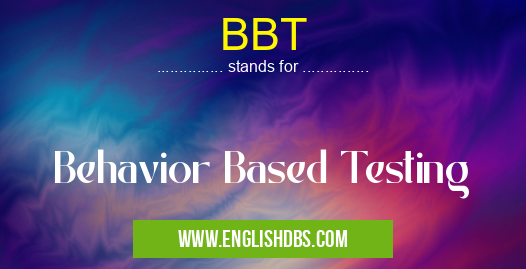What does BBT mean in UNCLASSIFIED
BBT stands for Behavior Based Testing which is a type of software testing, used to measure the behaviors of software applications. The main purpose of behavior-based testing (BBT) is to verify that the application behaves as expected or desired. It uses criteria based on user stories and other types of software requirements documents such as use cases and acceptance tests or functional specifications. Behavior-based testing is focused on the execution of application functionality in an efficient way.

BBT meaning in Unclassified in Miscellaneous
BBT mostly used in an acronym Unclassified in Category Miscellaneous that means Behavior Based Testing
Shorthand: BBT,
Full Form: Behavior Based Testing
For more information of "Behavior Based Testing", see the section below.
Essential Questions and Answers on Behavior Based Testing in "MISCELLANEOUS»UNFILED"
What is behavior-based testing?
Behavior-based testing is a type of software testing that focuses on how the software behaves in different scenarios. It involves breaking down the behavior of the system into testable components and then testing each individual component. Behavior-based testing helps find possible errors or unexpected behaviors of the software system.
What are the benefits of behavior-based testing?
Behavior-based testing offers several benefits compared to other types of software testing. These benefits include faster feedback loops, easier debugging, more comprehensive tests for different scenarios, and better coverage for nonfunctional requirements.
What is the difference between functional and behavior-based testing?
The primary difference between functional and behavior-based testing is that functional tests focus on what a system does, while behavior-based tests look at how it does it. Behavior-based tests are more focused on understanding the behavior of a system in specific situations, rather than just checking whether it functions according to specifications.
How does automation help with behavior-based tests?
Automation can be used to speed up and simplify many aspects of behavioral based testing such as running repetitive tasks or validating results against expected values. Automation also allows for more complex tests to be created with less effort and resources, increasing test coverage without sacrificing time or budget constraints.
What kind of tools are used for behavior-based testing?
Popular tools used for behavioral based testing include scripting languages like Selenium, Behave Pro, Cucumber BDD framework, FitNesse, JBehave Pro and Robot Framework. Each tool offers different features that can be useful depending on the type of project being tested and desired level of complexity.
Is there any risk associated with using behavior-driven development techniques?
Yes, there are certain risks associated with using BDD techniques such as incorrect assumptions about how the system will behave under certain conditions or an incomplete understanding of user requirements. In order to mitigate these risks proper planning and communication between all stakeholders before starting any development work is essential.
What should be considered when creating behavioral test cases?
When creating behavioral test cases it’s important to consider not just what’s expected from the application but also edge cases and unexpected inputs which could cause issues in production environments. Additionally it’s important to plan ahead when creating test cases so that complicated or difficult scenarios can be avoided where possible saving time later down the line when carrying out manual exploratory tests.
Why is it important to have a good understanding of user requirement when doing behavior driven development (BDD)?
The essence of BDD lies in its emphasis on gathering user requirements before writing any code. Knowing what users require from an application ensures useful automated checks can be written quickly which will provide greater confidence when making changes while mitigating risk at the same time. Without a thorough understanding of user requirements tests may miss critical points which could lead to unexpected issues later down the line.
How do you decide which scenario should be included in a behavioural driven development (BDD) workflow?
Choosing which scenarios should be included in a BDD workflow requires careful consideration since this can have a direct influence on productivity as well as ensuring quality standards are met throughout all stages of development life cycle . Some factors you may want to consider include value added by including each scenario , technical complexity , cost vs benefit ratio , release timeline etc.
Final Words:
Overall, Behaviour Based Testing (BBT) is an important tool that software developers can use when designing applications for customers or clients as it provides feedback from daily user scenarios rather than relying solely on unit tests based solely on code logic. This helps identify potential issues early on before launching into production saving valuable resources and time for parties involved. By understanding customer behaviour and adjusting accordingly based on findings from BBT ensures users have quality experiences with applications they use resulting in greater satisfaction overall.
BBT also stands for: |
|
| All stands for BBT |
